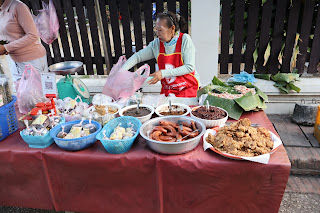The Morning Food Market in Luang Prabang is an outdoor market, with most of the vendors selling their wares under large umbrellas.
This small market is the Laotian "supermarket" where they come to buy their fresh fruit, vegetables and meat, which are proposed in showcases which are not always the way we use to see in most of our countries. Some products are coming from the jungle around Luang Prabang, and will be for sure highly exotic for travellers from western countries.
The Morning Food Market is starting when sunrise, and finishes usually before 9am.
You can find many unusual foodstuffs like ox-blood which is proposed in gelatinous cubes, serpents, bats, grilled insects (worms, grasshoppers, bee’s larvae, crickets, butterfly chrysalis), giblets covered with flies, caramelised pork’s head, and all sorts of leaves and plants which are used to make the traditional dishes.
You can find Thai products, cultivated in greenhouses, as well as the seasonal Lao products. Freshly caught fish, bunches of local flowers especially made for leaving in the temples as offerings, as well as many other items.
|
The butcher.
|
|
Selling fruit and vegetables. |
|
Selling grilled bananas. |
|
Selling different types of chilli. |
|
Selling cheap necklaces and bracelets. |
|
Selling spices. |
|
Selling fresh lychee. |
|
Selling grilled honeycombs. |
|
Selling raw meat. |
|
Making offerings in the spirit house.
|
|
Selling fish and eggs. |
|
Selling grilled sausages and salad. |
|
Selling sauces. |
|
Selling grilled kebabs. |
|
Selling sweet potatoes. |
|
Selling sticky rice. |
|
Selling Lao dessert with mango and pandan with shredded coconut on
top. |
|
Selling mangosteen. |
|
Selling Cake flour coconut (Khao nom kok). |
|
Selling eggs. |
|
Selling shrimp. |
|
Selling salted eggs and preserved eggs (pink). |
|
Selling sauces. |
|
Selling tree bark (left). |
|
Selling fruits and vegetables. |
|
Selling smoked fish. |
|
Selling fresh and smoked fish. |
|
Selling live frogs. |
|
Selling ready-prepared frogs. |
|
Selling Giant water bugs (Lethocerus sp.). |
|
Selling live eels. |
|
General view of the market with stalls on both sides of the
street. |
|
Saleswoman preparing jackfruit. |
|
Selling mushrooms. |
|
Selling rat kebabs. |
|
Selling already plucked chickens. |
|
Selling buffalo skin (Nung Yum). |
|
Selling peanuts in shell. |
|
Selling small birds in straw cages. |
See also
-
Xang Hai Village (Whiskey Village)
-
Pak Ou Village (Mouth of the Ou River Village)
-
Pak Ou Caves (Mouth of the Ou River Caves)
-
Alms Giving Ceremony
Source
Location












































